Employee health is a priority for many businesses worldwide and a clean and safe environment is something businesses focus on to reduce sickness-related absenteeism.
We all know that air pollution is one of the world’s largest health and environmental problems and usually AQI (Air Quality Index) is used to measure the quality of the air we breathe but it is mostly for outdoors.
What is often ignored is the quality of indoor air as we are basically an indoor generation that spends 90% of its life indoors.
Thankfully, as technology has picked up, air purifiers are becoming more and more accessible to the average family, so we wanted to take a look at 15 of the best options on the market today.
It’s our goal that we can help you find the right air purifier for you, your family, and your budget.
But First, What Exactly Do Air Purifiers Do?
Every day, there are all sorts of nasty things floating around in the air in our home, most of which we can’t even see. Smoke, gases, cleaning products, mold, and dust mites are just a few. Also, human skin flakes make up a big part of what we breathe in.
And with modern homes being so sealed from the outside world, all of those contaminants just linger in the air with nowhere to go but into our lungs. If that sounds disgusting, that’s because it is!
An air purifier can help ‘suck up’ those contaminants, which ultimately should provide better health outcomes for you and your family. One study, for example, found asthmatics who had an air purifier were 20% less likely to have to see their doctors.
It should be noted though, that most air purifiers don’t pick up the bigger things in the air, like pollen and mold. Some claim they do, but you will pay a decent premium for the privilege. Generally speaking though with the cheaper air purifiers, those particles fall to the ground, so to clean that up you’re better to do a regular vacuum clean of your floors, and wipe your surfaces.
All in all, though, the benefits of an air purifier in your workspace should provide a much healthier environment for you and your workers — and that’s going to keep your staff happy and healthy, as well as ultimately keep your productivity at optimal levels.
Now that we know what an air purifier does and doesn’t do, let’s have a look at what to look for when shopping around.
Things to Consider
When you first start looking at air purifiers, you’re likely to see a whole lot of specs and terms that can be pretty confusing. After all, purifying the air we breathe is serious science. Despite all of that geek-speak though, those specs and numbers are really just covering a few aspects of the air purifiers you’ll want to consider.
Let’s do a quick breakdown of what everything means, so you can decide what’s important to you and your family.
Room Size Suitability
This is listed first for good reason — the capacity of your air purifier should be suitable for the room or space you are putting it in. Generally, smaller air purifiers are for smaller areas, and larger air purifiers are for larger areas. Makes sense right?
There is very little use in using a small air purifier for a big area because it just won’t have the ‘oompf’ to get the job done. Conversely, if you get an air purifier that is unnecessarily powerful, you’re probably spending more money than you need to.
For our purposes, we’ll list each air purifier by the following sizes:
- Small — for small rooms or personals spaces under 300 square feet
- Medium — for rooms or spaces between 300 and 699 square feet
- Large — for rooms or spaces between 700 and 1,900 square feet
- Whole House — for very large spaces or whole houses.
Air Exchanges Per Hour
This is a reasonably simple one, in that it measures how many times an air purifier will exchange (or clean) the air in the room per hour. The more times per hour the air is exchanged, the harder the air purifier works to keep the air clean.
Remember that this rating is only applicable to its room size suitability as above. If you put an air purifier designed for a small room into a large room, its ability to exchange the air per hour will be greatly reduced.
Filter Type and Capability
This one can get confusing, so we’ll try and keep it simple. The reason that it can be confusing is that there are many different types of filters, and sometimes manufacturers will try and have their own names for filtration to make it sound better than others.
In saying that, we will try our best to translate things for you — here are the main filter types to look out for:
- HEPA (High-Efficiency Particulate Air) Filtration This is the one most people look for, as it’s tried and true. It uses a high-density paper filter to trap the dirt from the air. The specific term you’ll want to look out for is ‘True HEPA Filter’. If it says something like ‘HEPA Like’ or HEPA Type’, we’d generally suggest you stay away because it is just not as efficient as the real deal.
- Carbon Filtration This air filter uses carbon panels that absorb fumes in the air. Note it just traps fumes; that is to say, it will not trap contaminants, only bad smells from the air in the room. For that reason, carbon filtration is usually used in addition to HEPA filtration.
- Ionic Filtration This one is a bit more complicated, as it sends out charged ion particles into the room that then latch onto contaminants in the room. These contaminants then fall to the floor or other surfaces with gravity. Some of the more expensive ionic filtration devices will have a collection area that ‘suck in’ the contaminants from the air with electrostatic energy, so it reduces what falls on the ground or surfaces.
Then of course, more expensive options will have combinations of these filters or other filter technologies which we’ll explain as they arise.
Automatic Monitoring
This means that the air purifier will have sensors that can sense certain smells or contaminants, and automatically adjust to get rid of them as they arrive. Automatic monitoring is really handy for a set and forget arrangement.
Sound Level
All air purifiers will make a noise, usually a quietish humming sound. Generally, the more powerful the air purifier, the louder the sound, but more expensive models will have systems to keep them quiet. This may not be an issue for you at all, but it is for some. In our reviews, we’ll cover if they are exceptionally quiet, or louder than normal.
Energy Consumption
The best way to use an air purifier is to have it on all the time, and that can sometimes mean unpleasant surprises in your energy bill. Obviously the more energy an air purifier needs to run, the more expensive it will be to use.
Most air purifiers will have an eco mode, or be Energy Star certified to try and keep running costs down. In general, air purifiers are pretty energy efficient, costing not much more than $50 a year. But we will let you know whether any of our reviewed air purifiers will cost too much in energy!
Filter Change Indicator
It can be easy to forget exactly how long you have left your air purifier on, and therefore difficult to know when to change the filter. A filter change indicator is really handy for knowing when the filter needs replacing.
On Wheels/Moveable
The bigger an air purifier gets, the more cumbersome it might be to move from room to room. We’ve stated how easy each air purifier is to move.
Wi-Fi Capability
By no means a necessity, but you might find Wi-Fi capability handy to track the usage of your air purifier, or to see if it’s currently working, etc. This is also closely related to whether the air purifier has a mobile app, which we’ll make clear.
The Best Air Purifiers for 2024
| Product | Model | Room Size | Air Exchanges | Price |
|---|---|---|---|---|
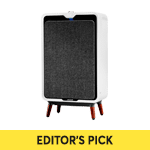
|
Bissell 2768A Air320 | Up to 1000 sq. ft | 3 per hour | |
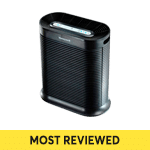
|
Honeywell HPA300 | Up to 465 sq. ft. | 5 per hour | |
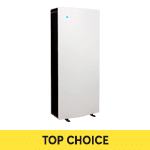
|
Blueair Pro XL | Up to 1180 sq. ft. | 5 per hour | |
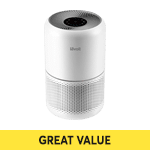
|
Levoit Core 300 | Up to 215 sq. ft. | 5 per hour | |
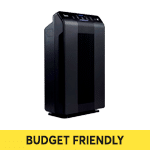
|
Winix 5500-2 | Up to 360 sq. ft | 4.5 per hour |
Editor’s Pick: Bissell 2768A Air320
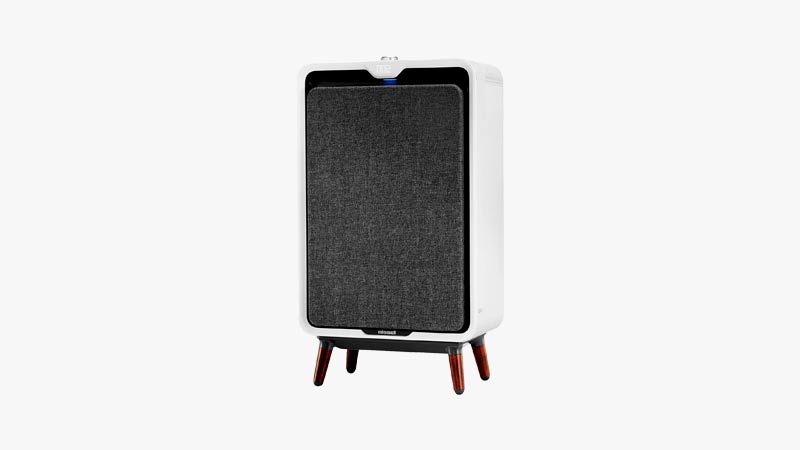
Firstly, how good looking is the Bissell air320? It looks like a retro HiFi speaker, and yet super modern at the same time. This thing would look good anywhere, and have guests asking what the heck it is! That may seem like something trivial, but you have to give Bissell credit for designing an air purifier that doesn’t look like a small refrigerator.
Using a three-stage filter, the Bissell air320 utilizes a pre-filter, a True HEPA filter, and finally, an activated carbon filter. With those three filters, it will clean the air of a 1,000 square foot space with relative ease, which is excellent for this price point.
While it doesn’t have all the bells and whistles of some of its competitors, it has good filtration, excellent looks, and huge coverage. Add to this its extremely accessible price point, we pick the Bissell air320 as our Editor’s Pick. Take a look at the reviews in the link and see what we’re talking about.
- Room Size Suitability: Large, up to 1000 square feet
- Air Exchanges Per Hour: 3
- Filter Type and Capability: 3 Stage Filtration including fabric pre-filter, an activated carbon filter and a high efficiency filter for pollen, dust, smoke, hair and dander
- Automatic Monitoring: No
- Sound Level: 37-59 dB
- Energy Consumption: 116 watts at highest setting
- Filter Change Indicator: No
- On Wheels/Moveable: No, but moveable at 18.25 lbs
- Wi-Fi Capability: No
Best Air Purifiers Under $100
1. LEVOIT Air Purifier Core 300
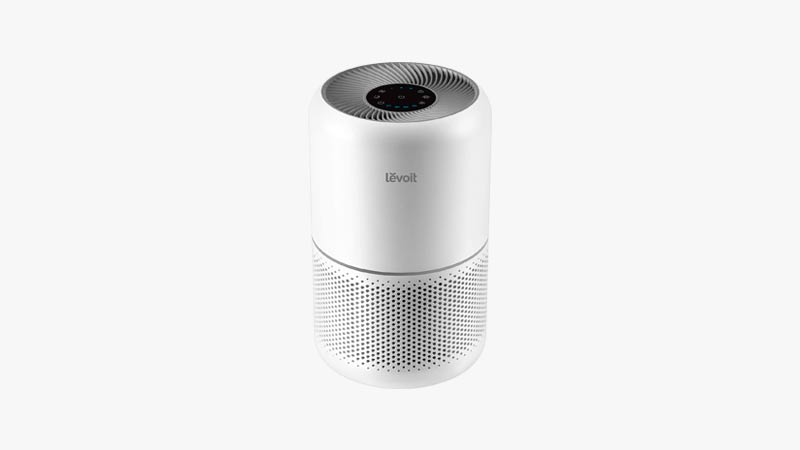
If you need an air purifier for just a small space, we don’t think you can go wrong with the Levoit Core 300. While it’s obviously not as feature packed as its more expensive cousins, it has all the basics right with a true HEPA system and five air exchanges per hour.
It’s also the smallest, lightest and most portable air purifier on our list, so you can basically carry it from room to room as you go. Oh, and it’s also extremely quiet, at just 24 dB at its lowest setting — you definitely wouldn’t be able to hear it if you were having a conversation.
Of course on the downside, you wouldn’t buy this for a large space, because it’s just not made for that. But if you have never bought an air purifier and want to start in a small bedroom or office, we’d definitely recommend the Levoit Core 300.
- Room Size Suitability: Small, 215 square feet
- Air Exchanges Per Hour: 5 times per hour
- Filter Type and Capability: True HEPA 3-Stage Original Filter for smoke, dust, and pollen
- Automatic Monitoring: No, timer only
- Sound Level: 24–50 dB
- Energy Consumption: 45 watts at highest setting, 0.8 on standby, Energy Star verified
- Filter Change Indicator: No
- On Wheels/Moveable: No, but small and portable
- Wi-Fi Capability: No
Best Air Purifiers Under $200
2. LEVOIT LV-PUR131
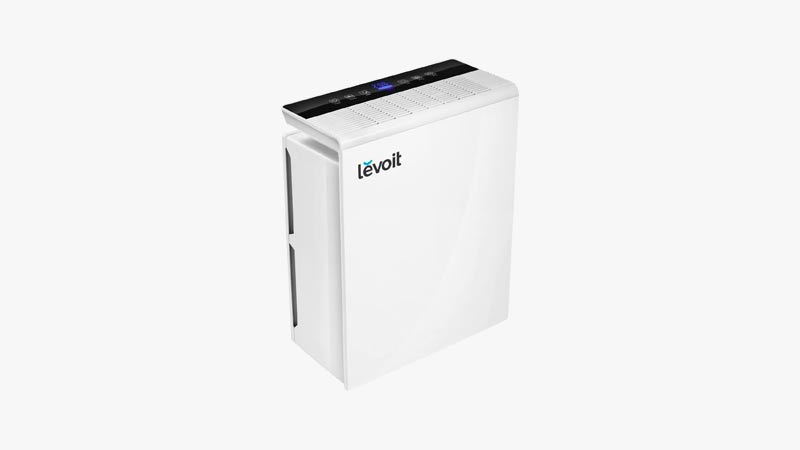
Stepping up in a big way, we’re starting to get into the air purifiers that can tackle medium-sized rooms and spaces. Not only is the Levoit LV-PUR131 capable of cleaning spaces of up to 360 square feet, it has a pre-filter, true HEPA filter, and an activated charcoal filter. That’s some pretty good bang for your buck.
Somewhat unusual for this price point, it can also detect the air quality in real time and switch between its three fan modes to clean the air accordingly. It is super quiet, and only uses 35 watts of power on average, so not bad, considering its performance.
On the other side of the coin, there are reports that it can get warm to the touch after many months of continuous usage, but this is easily manageable by turning it off every now and then and just opening some windows.
All in all the Levoit LV-PUR131 is a solid choice for small to medium areas when you are on a budget. Levoit has been around a while, so we don’t have any problems recommending them.
- Room Size Suitability: Medium, 360 square feet
- Air Exchanges Per Hour: 4.5 times per hour for 360 square feet
- Filter Type and Capability: 3 stage filter including True HEPA, Pre-Filter, and High-Efficiency Activated Carbon Filter for dust, allergens, bacteria and odors.
- Automatic Monitoring: Automatically changes between the 3 fan speeds to reflect air quality readings
- Sound Level: 27 dB -52 dB
- Energy Consumption: 35 watts, Energy Star and CARB certified
- Filter Change Indicator: Yes
- On Wheels/Moveable: No, but lightweight at 11.4 lbs
- Wi-Fi Capability: Yes
3. Winix 5500-2
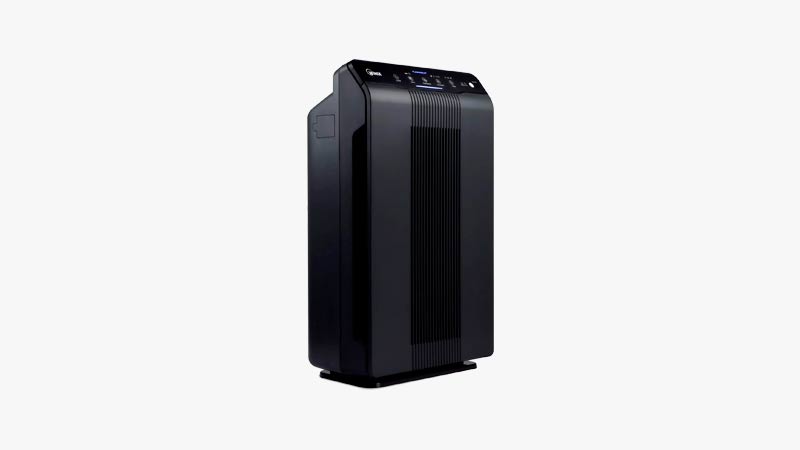
South Korea is very particular about their air quality, and Winix, hailing from South Korea, are no different. The Winix 5500-2 has a robust three-stage filtration process, using a True HEPA filter, a carbon filter, and Winix’s ‘PlasmaWave’ system, which is their version of an ionic filter.
While it can be reasonably loud at 58 dB (South Koreans really like their air to be clean), it can go as low as 28 dB, which isn’t too bad at all.
On the negative side, some users have noted a bad smell from the filters, but this shouldn’t be a problem if you clean them regularly. Also, some asthma sufferers seem to think the PlasmaWave system is irritating, but we can’t confirm that.
For the price, the Winix 5500-2 offers a bunch of features, excellent air purification capabilities, and all the technology you’d expect from South Korea.
- Room Size Suitability: Medium, 360 square feet
- Air Exchanges Per Hour: 4.5 times per hour for 360 square feet
- Filter Type and Capability:True HEPA Filter for pollen, mold spores, dust, pet dander, microbes, and smoke
- Automatic Monitoring: Yes
- Sound Level: 28 dB to 58 dB
- Energy Consumption: 70 Watts
- Filter Change Indicator: Yes
- On Wheels/Moveable: No, but moveable at 15.4 lbs
- Wi-Fi Capability: No, but has remote control
4. Honeywell HPA300

With a whopping 465 square feet of air cleaning coverage, the Honeywell HPA300 is the big boy at this price point, so it should cover most small to medium room needs.
The downside of all that coverage is that they only had the budget for a two-stage filter system, carbon, and then a True HEPA filtration system. So it’s really down to what you prefer, coverage or filtration at this price point.
It does have some cool modes though, like a germ mode, an allergen mode, and a turbo mode. In reality, that may not be too different from its competitors’ modes, but it certainly sounds reassuring.
While it does miss out on some other features, like no auto mode, and no remote control, if you want an air purifier that cleans a serious amount of air for under $300, go for the Honeywell HPA300.
- Room Size Suitability: Medium, 465 square feet
- Air Exchanges Per Hour: 5 times per hour
- Filter Type and Capability: 3 HRF-R HEPA filters and an HRF-AP1 prefilter for pet dander, pollen, dust, mold & smoke; It also helps capture certain germs & reduce odors.
- Automatic Monitoring: No
- Sound Level: 63 dB at max setting
- Energy Consumption: 40 - 130 watts on turbo setting
- Filter Change Indicator: Yes
- On Wheels/Moveable: No, moveable at 17 lbs
- Wi-Fi Capability: No
Best Air Purifiers Under $300
5. Dyson Pure Cool (TP01)
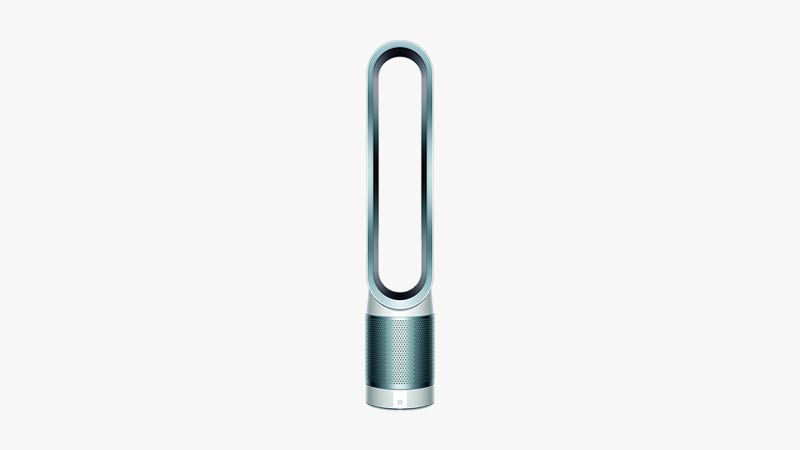
You know once you get to the Dyson models, you are moving up in the world. The Dyson Pure Cool TP04 is a large bladeless air purifier, and frankly, it wouldn’t be a Dyson if it wasn’t bladeless. Because of that design, it is slim but very tall at nearly 42 inches. We must admit, it does look very good though.
If you want the prestige of a Dyson appliance in your home without a second mortgage, the TP01 is the original Dyson air purifier that has been out since 2017. Because of the model’s age, you can now get one for under $300, which is 25% less than its original price.
It does not have all of the smart connectivity of its younger sibling the TP04, but it has the same filtration system and elegant design.
All and a very nice looking, functional air purifier that is worth a look if you are a fan of Dyson.
- Room Size Suitability: Medium, approx 500 square feet
- Air Exchanges Per Hour: Dyson does not release these specs
- Filter Type and Capability: True HEPA filter with an activated carbon filter for allergies, pets, dust, and pollen.
- Automatic Monitoring: Yes
- Sound Level: 40 dB - 56 dB
- Energy Consumption: 56 Watts
- Filter Change Indicator: No, but change once per year at $69 per filter
- On Wheels/Moveable: No, but moveable at 8.4 lbs
- Wi-Fi Capability: No
6. Blue Pure 211+
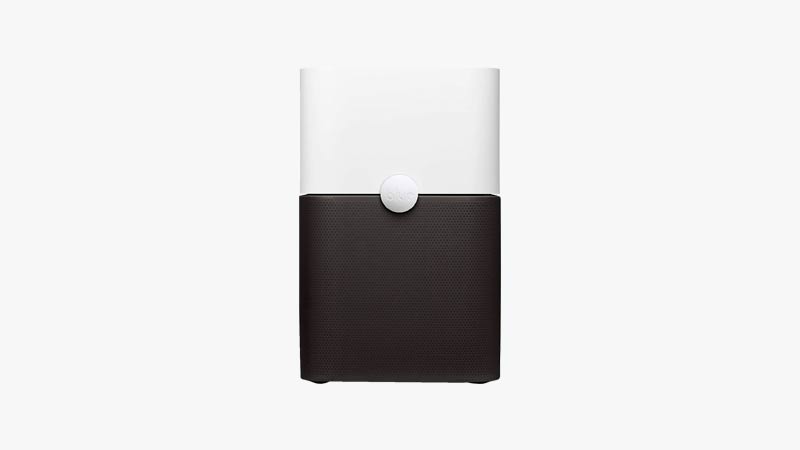
The Blue Pure 211+ is the midrange competitor from Blue Pure and therefore gets all of the important things right, with just a few compromises. It’s pretty small for the price point, and that is reflected in its relatively small 540 square foot cleaning capability.
While it does feature a three-stage filtration system, it does not feature a True HEPA filter, instead opting to use polypropylene fibers to capture dust, pet dander, etc. This might not be a deal-breaker for some, but we don’t see why they couldn’t have put in a true HEPA filtration system given there are sub $100 units that managed to do just that.
Despite its small size, it does have an air exchange rate of 5 times per hour so we can’t really fault it for that. It also has an Energy Star rating which means it should only cost you $10 to $20 a year to operate.
This is a good air purifier, don’t get us wrong, but we think there are other options with better features for the same price point. In saying that, if it is the right room size capacity for you, it will absolutely demolish bad air and return clean air every 12 minutes. That’s pretty impressive.
- Room Size Suitability: Medium, 540 square feet
- Air Exchanges Per Hour: 5 times per hour in room 540 square feet in size
- Filter Type and Capability: 3 level filtration system for Viruses, Pollen, Dust, Pet Dander, Mold, Bacteria and Odors
- Automatic Monitoring: No
- Sound Level: 31 - 56 dB
- Energy Consumption: 30 - 61 Watts
- Filter Change Indicator: No
- On Wheels/Moveable: No, but moveable at 13 lbs
- Wi-Fi Capability: No
Best Air Purifiers Under $500
7. Medify MA-112 H13 HEPA Air Purifier
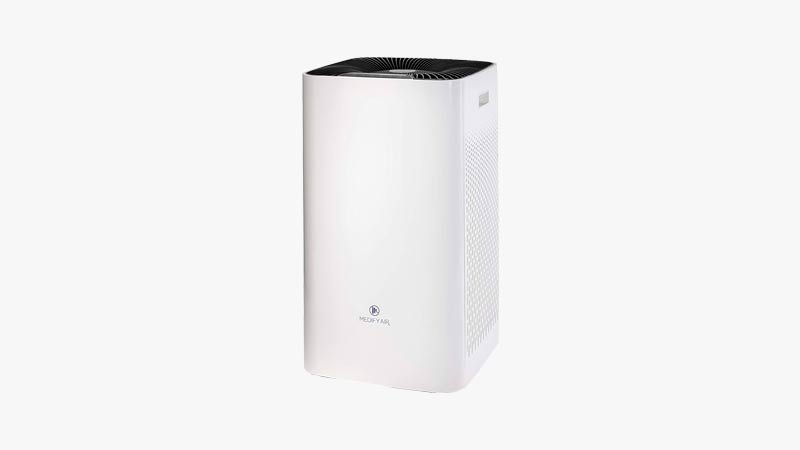
Moving up into the sub $500 category, the MA-112 is essentially the flagship model in the Medify line up. It features an impressive four-stage filtration process — pre-filter, True HEPA filter, activated carbon filter, and finally an ionizer.
On top of that four-stage filtration process, it will clean the air in a space up to a staggering 5,000 square feet, which is truly impressive for the price. It should be noted though, that at this size room, the air exchanges per hour is only one. Obviously, if it’s a 2,500 square foot space, that goes up to two exchanges per hour.
The cons of the MA-112? Well, its filters don’t last as long as its competitors, it has relatively high power consumption, and it some find it noisy on its highest speed.
Oh, and did we mention Medify offers a lifetime warranty on this model? Despite its relatively low air exchange rate, it excels in all other areas, so we’d definitely check this one out if you’re in the market.
- Room Size Suitability: Whole house, 5000 square feet
- Air Exchanges Per Hour: 2 times per hour in 2,500 square foot room
- Filter Type and Capability: Medical grade H13 True HEPA 3 Stage Filtration for Dual air Intake for Allergies, Smog, Odors, Smoke, Pets Dander and Dust
- Automatic Monitoring: Yes
- Sound Level: 70 dB at highest fan speed
- Energy Consumption: 95 Watts, ETL & Energy Star certified.
- Filter Change Indicator: Yes
- On Wheels/Moveable: Yes on wheels
- Wi-Fi Capability: No
8. Dyson Pure Cool (TP04)
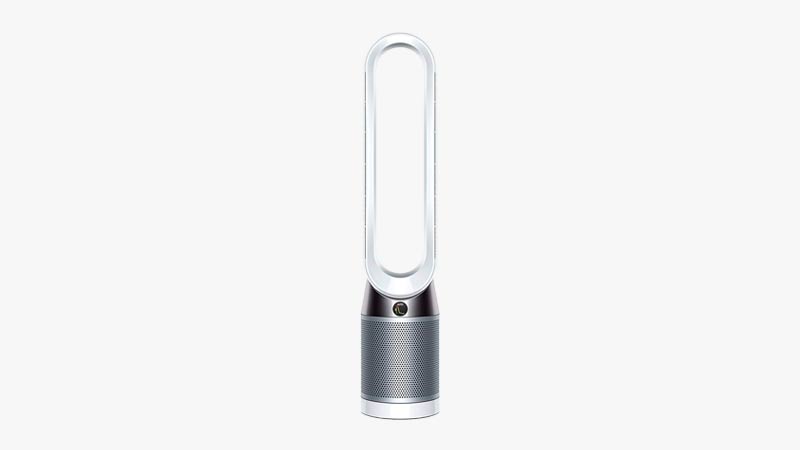
Moving up further in price in the Dyson world (which isn’t hard!), is the Pure Cool TP04.
It features a cool little screen at the base that gives you live updates of what the Dyson is monitoring in the air. You then have the choice of using the included remote, or free app on your phone to customize things further. So yes, that does mean you have real-time monitoring of the quality of your air, and what the Dyson is doing about it.
It does have some downsides, it’s very pricey, especially when you consider it’s designed for spaces of only 500 square feet. The Medify above quadruples that.
At the end of the day though, if you want something with all the bells and whistles, as well as the prestige of the Dyson brand, click through to have a closer look.
- Room Size Suitability: Medium, approx 500 square feet
- Air Exchanges Per Hour: Dyson does not release these specs
- Filter Type and Capability: True HEPA filter with activated carbon filter for allergies, pets, dust, pollen and mold spores
- Automatic Monitoring: Yes, automatically senses and reports air quality on screen and to app
- Sound Level: 40 dB on the lowest setting - 62.2 dB on the highest setting
- Energy Consumption: 56 Watts on the highest setting
- Filter Change Indicator: No, but change once per year at $69 per filter
- On Wheels/Moveable: No, but moveable at 10.89 lbs
- Wi-Fi Capability: Yes, and Alexa enabled
Best Air Purifiers Under $600
9. RabbitAir MinusA2
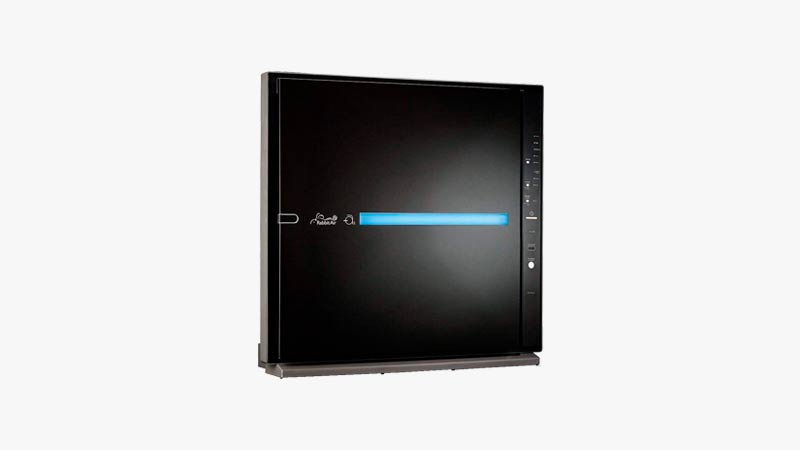
RabbitAir might not sound like a serious brand, but they have been leaders in air purification since 2004, so they know what they are doing. And we’re going to make the case that this is the best value deal for an air purifier in 2020.
Here’s the really good bit — the MinusA2 features a six (yes six) stage filtration process.
It goes like this:
- Pre-filter
- Medium-filter
- True HEPA filter
- Customized filter of your choice (germ defense, pet allergy, toxin absorber, or odor remover)
- Activated carbon filter
- Ion generators
That is quite simply, exceptional attention to detail for the price.
Speaking of attention to detail, it has a reasonably unique flat design, and to take advantage of that, RabbitAir offers a series of vinyl applications, with images by the likes of Monet and Van Gogh.
The only real downside we can find is its low fan speed, so all in all a great deal. We probably would have picked this as our Editor’s Pick, if it weren’t for the fact it was a few years old.
Honestly, if we wanted to talk about this air purifier as much as we wanted to, you’d assume we’d gone bonkers — but it really is that good. For most use-case scenarios, you couldn’t spend your hard-earned money more wisely to keep your home’s air healthy and clean.
- Room Size Suitability: Large, 815 square feet
- Air Exchanges Per Hour: 2 per hour in 815 square foot room
- Filter Type and Capability: 6 step filtration process including pre-filter, medium filter, BioGS HEPA Filter, customized filter, charcoal-based activated carbon filter and negative ion generator for pollen, lint, hair, mold spores, pet dander, dust mites, household odors, bacteria, light VOCs and chemicals, smoke, viruses.
- Automatic Monitoring: No
- Sound Level: 20.8 dB – 45.6 dB
- Energy Consumption: 47 Watts, Energy Star certified.
- Filter Change Indicator: Yes
- On Wheels/Moveable: No, but moveable at 19.4 lbs
- Wi-Fi Capability: No
10. Coway Airmega 400
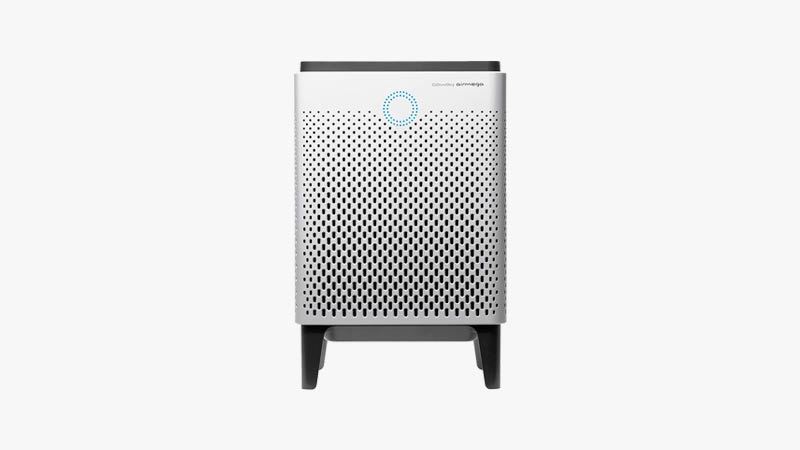
If you’ve got a lot of air to clean, and you’ve got less than $600 to spend, you should definitely look at the Coway Omega 400. Why? Well, it can clean a 1,560 square foot room in an hour. The air exchanges per hour go up to four if the space is 784 square feet.
It offers a four-stage filtration process, with two pre-filters, a true HEPA filter, and a carbon filter. Most customers comment on how quietly the Omega 400 goes about its business, which is impressive given how much air it can clean. It also offers a five year warranty for decent peace of mind.
On the downside, the filters, although only needing to be changed once a year, are expensive. It also doesn’t have Wi-Fi support which is odd at this price point.
If that doesn’t bother you though, and you want to clean a lot of air quietly, have a closer look at the Omega 400.
- Room Size Suitability: Large, 1560 square feet
- Air Exchanges Per Hour: 2 times per hour 1560 square foot room
- Filter Type and Capability: Combined activated carbon and True HEPA filter for pollen, pollutants and other allergens.
- Automatic Monitoring: Yes, including variable fan speed, sleep mode and eco mode. Can also set a timer.
- Sound Level: 43.2 dB on highest setting
- Energy Consumption: 64 Watts, Energy star certified.
- Filter Change Indicator: Yes
- On Wheels/Moveable: No, and heavy in weight at 25 lbs
- Wi-Fi Capability: No
Best Air Purifiers Under $800
11. Molekule MH1-BBB-1
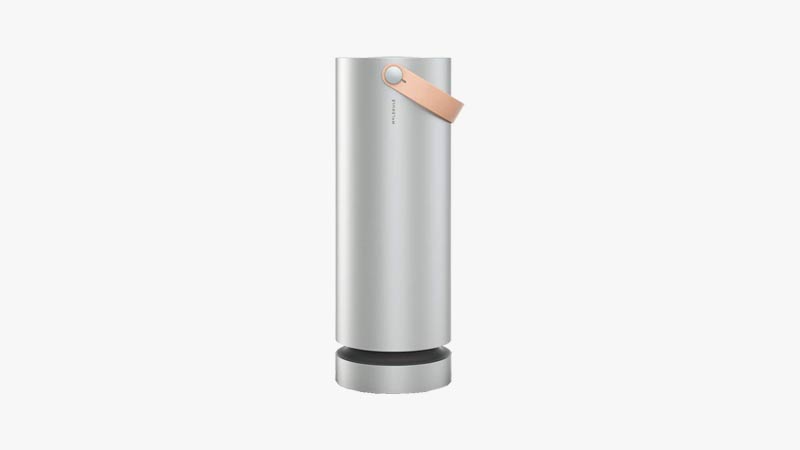
Molekule has been all over social media, so chances are if you’ve been shopping for an air purifier, you’ve seen this one around. The big thing that Molekule boasts about with their air purifier is their PECO technology. While a HEPA filter captures particles in the air, PECO filtration also captures gasses. It then breaks those gasses down into safe molecules.
Those PECO filters come at a cost and have to be replaced every six months at $65 a pack. The pack also includes two pre-filters that have to be replaced every three months.
Look, we’ll be honest, we don’t really recommend Molekule, as we found all that fancy new technology just doesn’t meet the hype. Sure, it does an adequate job, but we’d probably prefer the RabbitAir MinusA2 to the Molekule.
- Room Size Suitability: Medium, 600 square feet
- Air Exchanges Per Hour: 1 time per hour in 600 square foot room
- Filter Type and Capability: Pre-filter and PECO filter for VOCs, bacteria, mold, viruses, and allergens.
- Automatic Monitoring: Yes
- Sound Level: 30 dB - 55 dB
- Energy Consumption: 20 watts at lowest setting - 80 watts at highest
- Filter Change Indicator: Yes notifications via App
- On Wheels/Moveable: No, and heavy in weight at 24.6 lbs
- Wi-Fi Capability: Yes, through Wifi and App
Best Air Purifiers Under $1300
12. IQAir [GC MultiGas Air Purifier]
![IQAir [GC MultiGas Air Purifier]](https://www.omnicoreagency.com/wp-content/uploads/2020/04/IQAir-GC-MultiGas-Air-Purifier-List.jpg)
Okay, let’s get this out of the way. The IQAir looks something like a cross between a PC from the 90’s and an office building. So not off to a good start. But can its features make up for the lackluster design? Short answer, Absolutely, yes.
The long answer is that its four-stage filtration process combines to be 100x more effective than normal HEPA air purifiers. That puts it at a medical grade, so when you think about it for home use, that’s pretty crazy. Add to that its capacity to clean the air in a 1,125 square foot space, and a very compelling offer starts to take form.
Yes, it’s expensive, but if you need a medical-grade air purifier to save you from smoke, asthma, or allergies, we strongly recommend the IQAir.
- Room Size Suitability: Large, 1,125 square feet
- Air Exchanges Per Hour: 2 per hour for 1,125 square foot room
- Filter Type and Capability: IQAir's HyperHEPA filters for Odors, Smoke, Allergies, Pets, Asthma, Pollen and Dust
- Automatic Monitoring: Yes
- Sound Level: 59 dB at highest setting
- Energy Consumption: 20 Watts at lowest setting - 135 Watts at highest 6 speed fan setting
- Filter Change Indicator: Yes
- On Wheels/Moveable: No, and heavy in weight at 29 lbs
- Wi-Fi Capability: No
Best Air Purifiers Under $1500
13. LG AS560DWR0 PuriCare
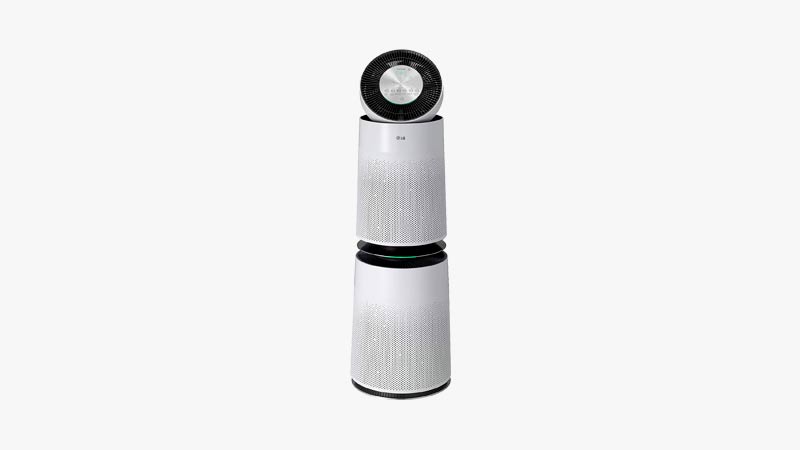
We’re moving into some serious money with the LG PuriCare 360, so we were interested to see if it could justify the price.
While LG says it’s suitable for space of up to only 512 square feet, we found it was pretty remarkable in its overall performance. Being LG, it’s the little touches that make the PuriCare 360 stand out.
Yes, as the name implies, it cleans air from 360 degrees around, but that’s not uncommon. However when you see details like that it can clean at a whisper quiet 25 dB, or that it purifies air closer to the ground for toddlers, the price starts to make a bit more sense.
It certainly does not skimp on the usual specs either:
- Its True HEPA filter catches allergens and ultra fine dust down to .3 microns, which is just 0.0003 mm!
- The LG Puricare 360 has an automatic sensor to keep track of air quality, as you would expect at this price point. However this model has a PM 1.0 sensor (whereas most models only have a PM 2.5 sensor), so it can detect even the tiniest particles in the air around you.
- It will also catch the odors and pollution in the air with it’s deodorization filter.
- If you have allergies or asthma, it is Asthma and Allergy Foundation of America Certified friendly.
It’s pricey, we agree, but overall, it’s probably the best air purifier for integrating into the modern smart home on our list. There’s nothing better than saying “Alexa, clear the air!”
- Room Size Suitability: Medium, 512 square feet
- Air Exchanges Per Hour: 4
- Filter Type and Capability: True HEPA filter for dust, VOC’s, allergens and odours
- Automatic Monitoring: Yes, fan speed and operation mode adjust automatically
- Sound Level: 25 dB
- Energy Consumption: 18 Watts at lowest setting - 85 Watts at highest setting
- Filter Change Indicator: Yes
- On Wheels/Moveable: No, and heavy in weight at 59 lbs
- Wi-Fi Capability: Yes, and Google Home and Alexa enabled
Best Air Purifiers Under $3000
14. Blueair Pro XL
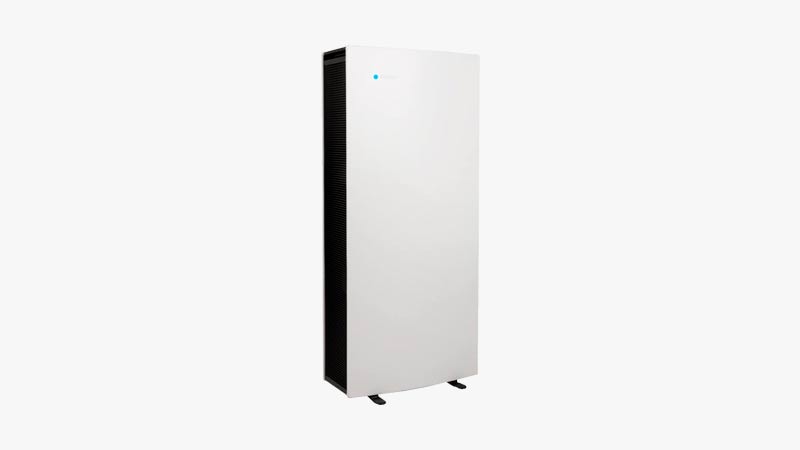
We really are at the top of the mountain with the Blueair Pro XL, and the air is crisp and clean. This thing is a beast — it has three giant fans, all with their own dedicated filtration system to inhale more air than anything else on this list. And you’d expect that for the price.
What’s crazy, is even with those three massive fans, it can still operate at as low as 32 dB, which is a huge achievement. There is no getting around the power consumption though, as it can use up to 256 watts. Although if you can afford the Blueair Pro XL, you’re probably not too worried about that.
You won’t be surprised to know however that it covers a huge 1,180 feet, and it can do that 5 times an hour. Wow.
One huge, huge omission though, is its lack of smart features, such as Wi-Fi or control from a mobile device. We suppose that Blueair would make the argument that the Pro XL is about performance, not fancy add-ons.
Bottom line, this is the Rolls Royce of air purifiers — it’s simply the best you can get. But for most people, well, it’s probably a bit too much.
- Room Size Suitability: 1000 square feet - 1180 square feet
- Air Exchanges Per Hour: 5 times per hour for 1180 square foot room
- Filter Type and Capability: True HEPA filter for allergens, mold, dust, pet dander, smoke particles and pollen
- Automatic Monitoring: Yes
- Sound Level: 32 dB - 58 dB Energy Consumption: 33 - 256 Watts
- Filter Change Indicator: Yes
- On Wheels/Moveable: No, and heavy in weight at 71 lbs
- Wi-Fi Capability: No
Conclusion
And just like that, we’ve gone through the best 15 air purifiers for every budget. From small and light, right through to something the size of a small refrigerator, we’ve reviewed them all.
We really do hope that we’ve given you enough information to know what to look for in an air purifier, as well as give you a wide range of options to fit your needs.
When it comes down to it though, our favorite, and our Editor’s Pick, is the RabbitAir MinusA2. There are more expensive and feature-laden options out there, but the MinusA2 just packs so much performance into such an accessible price point that we can’t recommend it enough.
Did you like our picks? Perhaps you have your own favorite. Let us know in the comments!
Photo Credit: Unsplash


